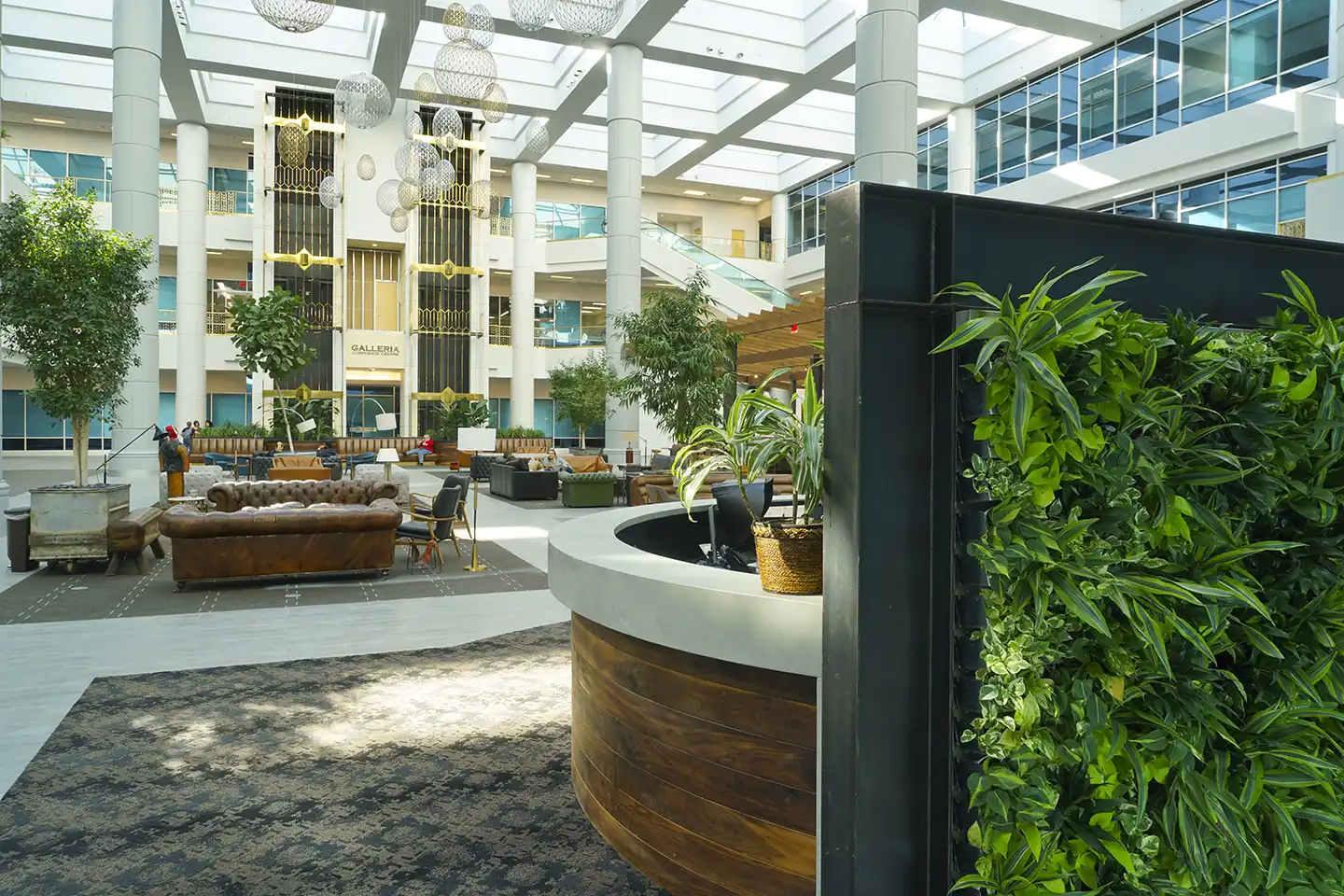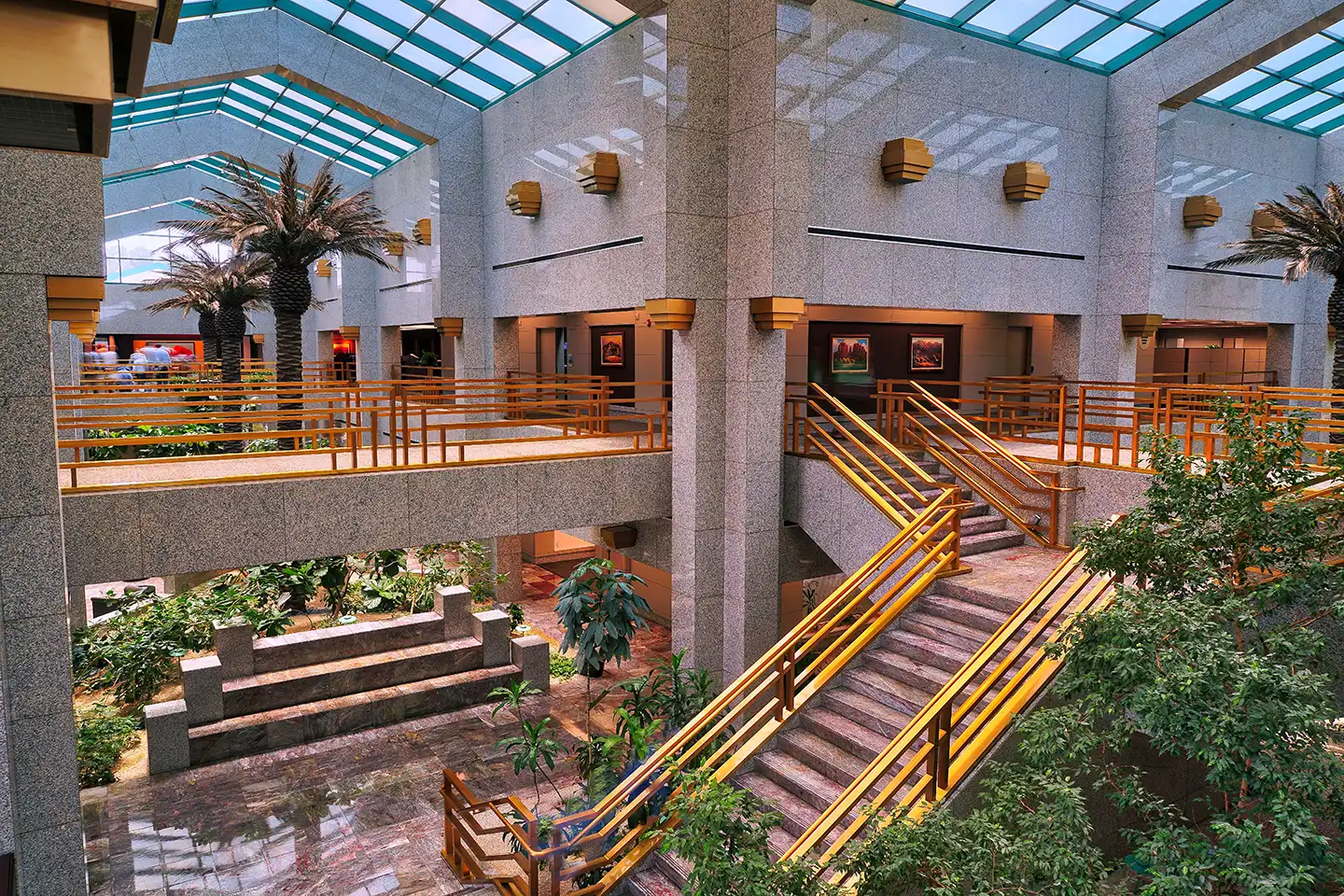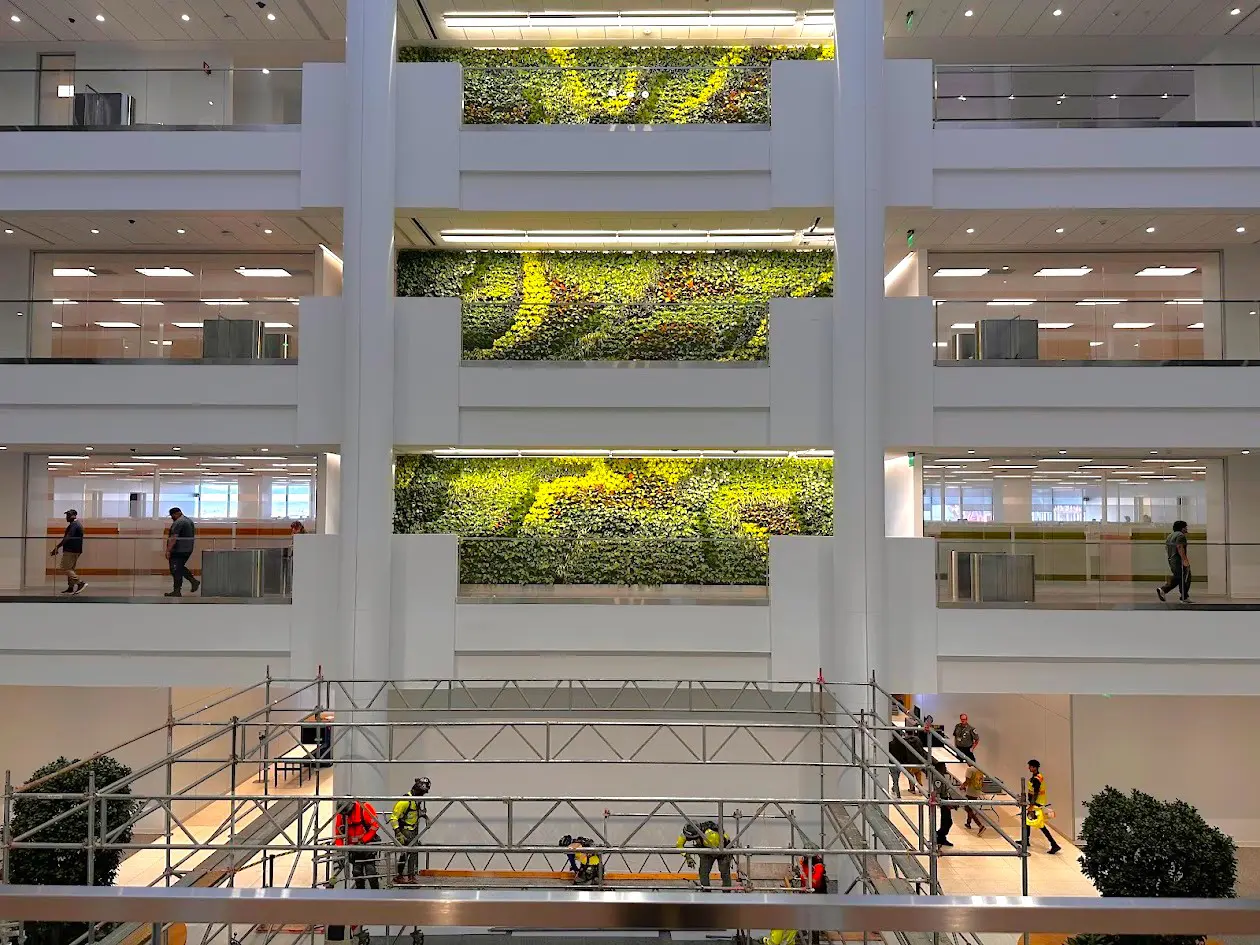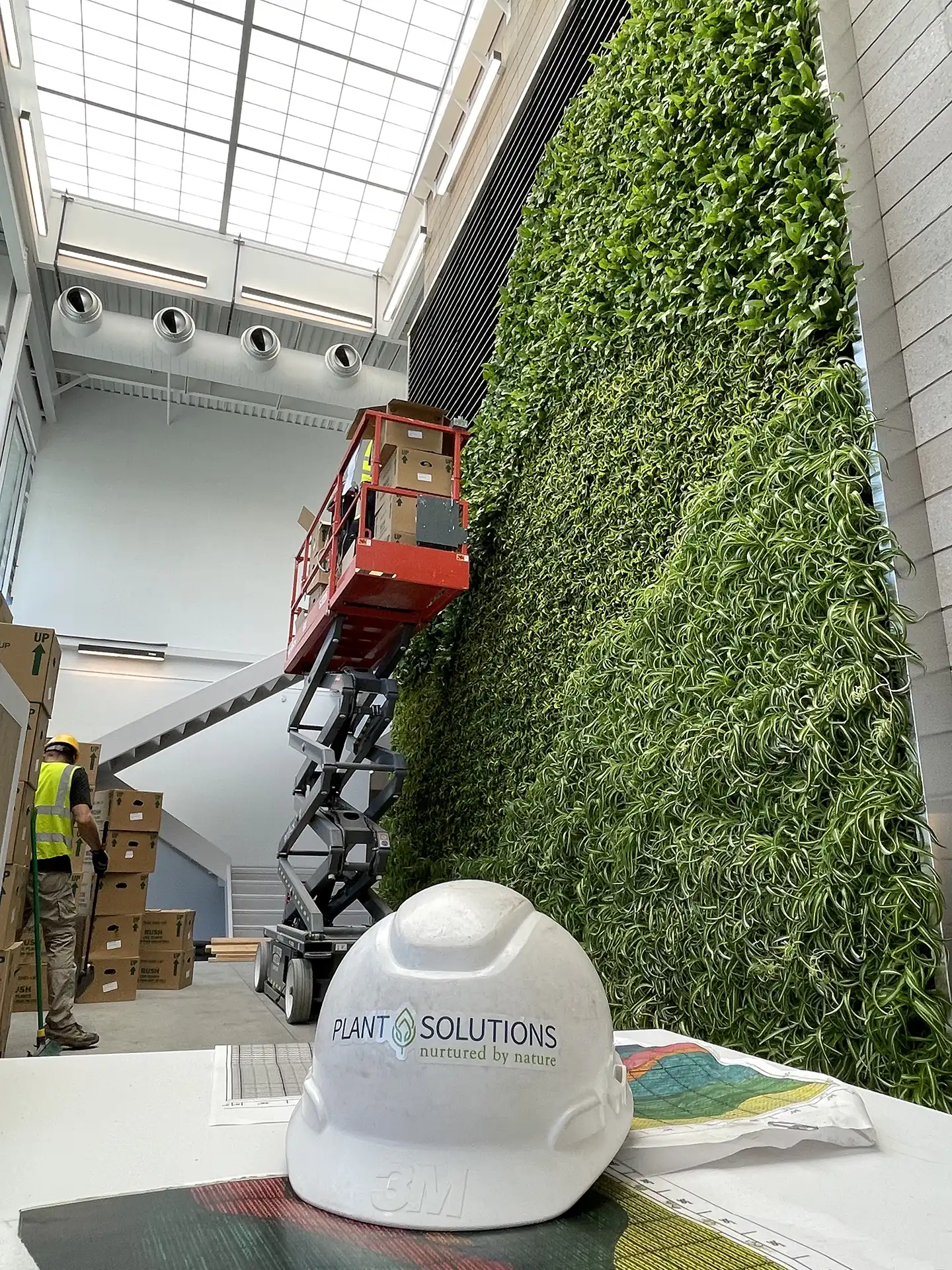In this exploration of sustainable design, we delve into the pivotal role of plants in architecture, redefining the way we perceive and interact with built structures. Partnering with plant design experts becomes indispensable as we navigate the intricate challenges of architectural innovation, ensuring that every space not only meets functional requirements but also enhances human well-being. In this post, we uncover how plants in architecture revolutionize spaces, creating sustainable and harmonious environments that inspire and elevate.

Plants in Architecture: Understanding the WELL Building Standard
The WELL Building Standard (WELL) is a revolutionary framework that enhances human health and well-being through the built environment. With a holistic approach, WELL emphasizes the integration of elements that purify air, boost mental health, and create overall livable spaces. Plants are paramount in meeting various WELL criteria, with their innate qualities of air purification, ability to provide a visual connection to nature, and how they offer a calming presence that enhances occupants’ mental health, the role of plants in architecture to achieve WELL certification cannot be overstated.
Transform Your Space with Sustainable Design
Are you ready to enhance your building’s health and well-being while achieving top sustainability certifications like WELL, LEED, and the Living Building Challenge? Let us help you integrate nature into your design. Contact us today to get started on creating a healthier, more beautiful environment.
Embracing LEED Certification
In addition to WELL, the Leadership in Energy and Environmental Design (LEED) certification is another prominent benchmark that focuses on environmental impact and sustainability in building. LEED emphasizes efficient use of resources, reduced carbon emissions, and improved indoor environmental quality. Incorporating plants into architectural designs contributes significantly to achieving LEED points. By enhancing air quality, providing natural aesthetics, and contributing to energy efficiency through natural insulation, plants play a crucial role in supporting the objectives of LEED certification, creating spaces that are not only environmentally responsible but also healthier for occupants.

Exploring the Living Building Challenge
Parallel to WELL and LEED, the Living Building Challenge (LBC) sets a high bar for sustainable building practices. This rigorous performance standard demands the utmost in environmental design and construction. In an August 2023 post we delve into the Living Building Challenge alongside architect Jason McLennan.
Plants impact several key Petals of the LBC. In the Place Petal, integrating native plants helps protect nature and fosters a connected community. Under the Water Petal, plants assist in water management systems, such as rainwater catchment and greywater recycling, ensuring buildings use only the water they can harvest on-site. For the Energy Petal, plants improve energy efficiency by providing natural shading and insulation, helping buildings produce 105% of their energy needs.
The Health and Happiness Petal benefits from plants enhancing air quality and providing a visual connection to nature, boosting well-being. The Materials Petal promotes using materials that do not harm the environment or health – using sustainable plants for landscaping aligns with this goal. Furthermore, the Equity Petal ensures accessible spaces for all, and plants enhance public spaces by creating inclusive areas that provide access to nature for everyone. Finally, the Beauty Petal encourages thoughtful design to inspire and elevate lives, with plants enhancing aesthetic appeal and creating uplifting environments.
Integrating plants across these Petals fosters sustainability and enhances the built environment’s well-being and beauty.
Benefits of Integrating Plants in Architecture
- Enhanced Air Quality: Plants naturally filter pollutants and improve indoor air quality.
- Mental Health Boost: The presence of nature reduces stress and enhances mental well-being.
- Aesthetic Appeal: Plants add a visual connection to nature, creating more inviting and beautiful spaces.
- Sustainability: Green installations contribute to a building’s sustainability credentials by promoting biodiversity.
However, achieving these benefits is challenging. Architects and designers need help integrating plants in architectural projects, mainly when aiming to meet WELL, LEED and LBC standards.

Challenges of Integrating Plants in Architecture
Space Constraints
- Limited Space: Urban environments and small interiors can restrict the available space for incorporating plants. Finding creative ways to include indoor plants without sacrificing usable space is essential.
- Vertical Integration: Utilizing walls and vertical spaces for plant installations can be challenging to design and maintain, requiring innovative solutions to maximize greenery in minimal spaces.
Maintenance and Sustainability
- Upkeep: Ensuring that plants receive adequate water, light, and care can be demanding, especially in large or complex projects. Early planning to account for necessary maintenance helps negate potential issues and keeps the project on track.
- Sustainability: Selecting sustainable, low-maintenance plants that thrive indoors without excessive resources can be difficult. Partnering with plant experts can help identify the best species for specific environments.
Environmental Factors
- Light Availability: Addressing insufficient natural light is crucial for plant health; key considerations should include integrating supplemental grow lights and strategically designing plant placement to enhance growth.
- Air Quality: Ensuring adequate ventilation and using air-purifying plants can help maintain a healthy environment for both plants and occupants. Poor air circulation and indoor pollutants can negatively impact plant health and longevity.
Structural Considerations
- Weight Load: Installing green walls and large planters can significantly add weight, requiring structural assessments and potential reinforcements.
- Waterproofing: Protecting building materials and interior finishes by preventing water damage from plant watering is essential.
Cost and Budget
- Initial Costs: Integrating high-quality plant installations can have a significant upfront cost. It is crucial to plan and budget for these expenses early in the design process.
- Long-Term Expenses: Ongoing maintenance costs must be budgeted, including plant replacement and care. A maintenance plan with plant care specialists can ensure longevity and sustained beauty.
Aesthetic and Design Integration
- Cohesive Design: Achieving a harmonious balance between plant installations and the space’s overall aesthetic can be complex. Working with plant design experts ensures that the greenery complements the architectural vision while also being functional for long-term plant health.
- Client Preferences: Aligning plant choices and design with client expectations and preferences while maintaining functionality and sustainability can be challenging. Open communication with clients and plant design professionals will allow clients to explore various options that can help meet these needs.
Accessibility and Safety
- Accessibility: Creating maintenance pathways and ensuring easy access is essential for designing plant installations that are obtainable for care without disrupting the space’s functionality.
- Safety Concerns: A key consideration is that plants do not obstruct pathways or create safety hazards. Thoughtful placement and secure mounting can prevent accidents.

Partnering with Plant Design Experts: Key to Overcoming Architectural Challenges
Addressing these pain points requires careful planning and collaboration with plant design experts who can offer innovative solutions and specialized knowledge. These professionals can assist architects in the following:
- Streamlining Plant Integration: With extensive experience in WELL, LEED and LBC certifications, Plant Solutions simplifies the integration of plants into architectural designs, ensuring all paperwork is accurate and timely.
- Enhancing Project Longevity: By collaborating with experts early on in biophilic design, architects can avoid common pitfalls and improve the longevity of their projects. Plant Solutions offers specialized services that address critical aspects of plant integration.
- Reducing Redesign Costs: By providing precise, customized millwork specifications that accommodate plant installations from the beginning, architects and designers avoid retrofitting issues and reduce the need for costly redesigns or modifications.
- Selecting Suitable Plant Species: Experts recommend plants that thrive in specific indoor conditions, reducing maintenance needs and ensuring long-term success.
- Designing Effective Watering Systems: Plant Solutions ensures cost-effective, environmentally friendly solutions by determining when integrated watering systems are essential; balances financial and sustainable considerations while maintaining plant health by LBC guidelines.
- Creating Cohesive and Accurate Design Plans: Our expertise seamlessly integrates plants into the overall architectural vision, resulting in a harmonious, aesthetically pleasing, and sustainable environment. We ensure all drawings and plans include necessary accommodations for living walls and plant installations, preventing construction delays and meeting both aesthetic and sustainability standards.
- Providing Ongoing Maintenance Support: Comprehensive maintenance plans, professional horticulture services, plant warranties, and system maintenance guarantees to keep plants healthy and vibrant over time. Continuous maintenance is essential for meeting the ongoing requirements of the LBC.
- Ensuring Certified Excellence: Plant Solutions guarantees every project’s highest quality and protection by holding licenses and certifications. This partnership ensures compliance with current standards and supports future sustainability and well-being of the built environment.
By working with plant design experts, architects can overcome the challenges of integrating greenery into their designs while achieving WELL, LEED and LBC standards. This collaboration leads to the creation of functional, beautiful, and sustainable spaces that enhance the well-being of their occupants.
Plants in Architecture Elevate Wellness and Sustainability
Integrating plants in architecture is a powerful strategy for achieving wellness and sustainability in the built environment. The WELL, LEED and LBC standards provide a robust framework for incorporating greenery to enhance air quality, mental health, and livability. However, the challenges associated with this integration require thoughtful planning and collaboration with plant design experts.
Architects can create spaces that meet and exceed wellness and sustainability goals by addressing space constraints, maintenance needs, environmental factors, structural considerations, cost, aesthetic integration, compatibility, and safety concerns. Partnering with plant specialists ensures that every project reaps the full benefits of biophilic design, resulting in healthier, more vibrant, and truly exceptional built environments.
As you embark on your next architectural project, consider the transformative power of integrating plants and the value of collaborating with plant design experts at Plant Solutions. Together, we can achieve a future where wellness and sustainability are at the forefront of every building we create.
Ready to Enhance Your Space?
Fill out the form below, and one of our experts will reach out to you to discuss how we can help you achieve a healthier, more sustainable building.
Let’s create something amazing together!
